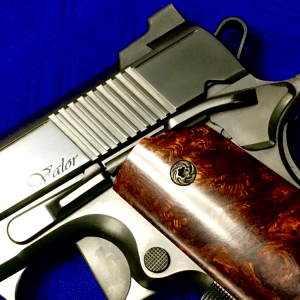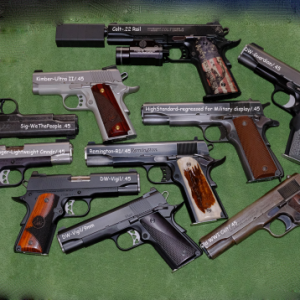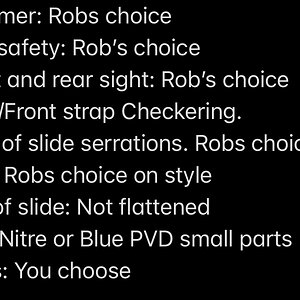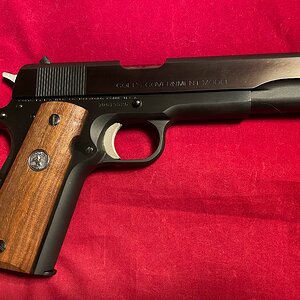- Joined
- Feb 16, 2018
- Messages
- 127
Several members here have asked if I would post the review I did of the Ruger SR1911 back in the summer, so here you go! Many of you may have seen it before but for those that haven't I hope you enjoy it as one persons professional evaluation of an out of the box 1911...
This is my review of the Ruger SR1911 I received into the shop today. This is a gun I purchased from a distributor personally so there was no chance at getting a "biased" one (if there is such a thing) from a rep. I believe the measurements listed below to be what a person could expect should they decide to purchase one commercially at the time of this evaluation and writing.
I will first list all the measured specs along with some personal comments based on how I would normally build a gun from scratch. At the end I will give my overall impression of the firearm and recommendations. Please keep in mind that at the time of this writing I have not shot the gun. I have simply taken it apart, evaluated and measured it piece by piece. My personal comments and opinions you will read below are simply that, my personal views. My comments regarding what the numbers are or should be can be backed up by not only the 30+ years of study and guns built by my mentor Bob Marvel, but also the guns I have built in the past that have and continue to perform for their owners at the highest level of reliability and accuracy.
Slide to Frame Fit:
The frame rails measure .74860" in width, .0990" and .0985" in height, and the way of the frame measures .1185" and .1180 respectively.
The slide way measures .7580" in width, .1045" in height, and the rails of the slide measure .1160" and .1165" respectively.
This allows for a difference of .0094" side to side (horizontal) and about .002" up and down (vertical). Typically when fitting a slide to frame I shoot for between .0002"-.0005" horizontal and less than .001" vertical. The good news is the slide checks out as being parallel in the ways and rails so it would be an easy cure to have the frame rails welded up and re-machined if a person desired a better fit.
The slide does overhang the rear of the frame by about .008" which would be barely noticeable to most and it a great deal better than many of the production guns on the market today.
Barrel and Barrel Fit:
The o.d. of the barrel measures .5812" in the bushing bearing area and .5750" past that area. The area underneath the radial lugs has not been relieved and may cause binding on the frame during cycling. This area should be relieved in my opinion.
The bushing i.d. measures .5835" for a tolerance of .0023". While this is much tighter than other "stock guns" I have measured it is not what I would consider "match". In my opinion a "match" fit bushing should have a difference in tolerance of less than .001" when fit properly with the correct reliefs made to allow for function.
The bushing o.d. is .6967" and the slide i.d. is .703" for a tolerance of .0063". The bushing also has play fore and aft in the slide. The bushing is in other words very loose in the slide which is not uncommon on "stock" guns. It does however affect accuracy and is easily corrected with a new properly fit bushing.
The barrel is not finish crowned which does affect the accuracy as it can cause the bullet to leave the bore unevenly.
The barrel hood to breach face gap on this pistol measured .008". The range for best accuracy is from less than .001" to .0025" max with a correct match chamber depth of .905"-.908". Unfortunately due to the loaded chamber cut in the top of the hood I do not think this issue could be corrected by welding and re-machining the hood. However, I will explore the possibility as I feel it would enhance the accuracy.
The chamber is not finish reamed and is not polished. It measures .898" from the back of the hood. The barrel throat is the proper concave shape but is unpolished.
There is no perceptible fit between the barrel legs and the slide stop pin. The legs measure .0915 from the outside edge of the link pin hole to the flat. The link bridge (the part that corresponds to the height of the barrel legs) measures .099" meaning that the slide stop is resting on the link as opposed to the barrel legs. The slide stop link hole measures .204" which is part of the reason the barrel has barrel bump on the front of the legs as the barrel does not have enough movement during cycling due to the tight link hole to help prevent the legs from bumping the slide stop. It may be possible to have some leg fit on the barrel if a new bushing and slide stop were installed in the gun. Having the slide lowered on the frame by means of either accu-rail, peening or welding and re-machining would also aid in acquiring barrel fit on the legs.
The slide stop appears to be MIM. The pin measures .1965" in diameter and has a flat on the bottom. It is also shaped in such a way on the nose as to cause rounds to bump it during feeding causing accuracy and reliability issues.
Extractor:
The extractor is very close to the correct specs for length from the front of the firing pin stop slot to the rear edge of the hook at 2.257" (correct measurement is 2.250" +/- .005"). It does have a bit too much tension but this appears to be caused by the fact that the tip of the hook is slightly too fat allowing the round to be held by said tip on the rebate of the round instead of on the rim of the case by the flat of the extractor. This causes accuracy and reliability issues as it does not allow the round to be held in the chamber the same each time and causes an interruption in the feeding process.
Guide Rod, Plug and Recoil Spring:
The guide rod appears to be a solid stainless steel piece of government length. It is not modified on the back side which is allowing it to hit the front of the barrel legs during cycling. This affects both accuracy and reliability. The plug has not been beveled on the inside edge which causes the spring to bind slightly while cycling. The spring is 20 pound which in my opinion is a bit heavy. A correct spring weight would be 18 pounds for normal ball and self defense type loads.
Frame:
The magwell of the frame has been opened evenly and cleanly to allow for easier mag insertion.
The vertical impact surface (VIZ) has little to no relief which over time will allow the barrel legs to strike low in the frame which can cause the legs to break off the barrel.
The frame ramp is machined to a depth of .425" which is good. However, it appears to have been plunge cut with a 15/32" cutter and is therefore not wide enough to feed most hollow point or wadcutter loads. This needs to be widened. It has also not been moved forward too much which would allow for the fitting of a Kart NM barrel without much difficulty.
Three of the four grip screw bushing protrude into the frame which can cause certain mags to hang up when attempting to eject them.
Ejector:
The ejector is an extended variety that has been pinned in place. It is of a suitable length at 1.060 from front to back. However, the nose has been shaped at a downward angle as opposed to a rearward angle which would be preferred for consistent ejection.
Ejection Port:
The ejection port has been cut to a depth of .450" from the bottom of the slide with a radius of 3/8". While this is sufficient, it would serve better were it lowered to a depth of .400" with a ¼" cutter.
continued...
This is my review of the Ruger SR1911 I received into the shop today. This is a gun I purchased from a distributor personally so there was no chance at getting a "biased" one (if there is such a thing) from a rep. I believe the measurements listed below to be what a person could expect should they decide to purchase one commercially at the time of this evaluation and writing.
I will first list all the measured specs along with some personal comments based on how I would normally build a gun from scratch. At the end I will give my overall impression of the firearm and recommendations. Please keep in mind that at the time of this writing I have not shot the gun. I have simply taken it apart, evaluated and measured it piece by piece. My personal comments and opinions you will read below are simply that, my personal views. My comments regarding what the numbers are or should be can be backed up by not only the 30+ years of study and guns built by my mentor Bob Marvel, but also the guns I have built in the past that have and continue to perform for their owners at the highest level of reliability and accuracy.
Slide to Frame Fit:
The frame rails measure .74860" in width, .0990" and .0985" in height, and the way of the frame measures .1185" and .1180 respectively.
The slide way measures .7580" in width, .1045" in height, and the rails of the slide measure .1160" and .1165" respectively.
This allows for a difference of .0094" side to side (horizontal) and about .002" up and down (vertical). Typically when fitting a slide to frame I shoot for between .0002"-.0005" horizontal and less than .001" vertical. The good news is the slide checks out as being parallel in the ways and rails so it would be an easy cure to have the frame rails welded up and re-machined if a person desired a better fit.
The slide does overhang the rear of the frame by about .008" which would be barely noticeable to most and it a great deal better than many of the production guns on the market today.
Barrel and Barrel Fit:
The o.d. of the barrel measures .5812" in the bushing bearing area and .5750" past that area. The area underneath the radial lugs has not been relieved and may cause binding on the frame during cycling. This area should be relieved in my opinion.
The bushing i.d. measures .5835" for a tolerance of .0023". While this is much tighter than other "stock guns" I have measured it is not what I would consider "match". In my opinion a "match" fit bushing should have a difference in tolerance of less than .001" when fit properly with the correct reliefs made to allow for function.
The bushing o.d. is .6967" and the slide i.d. is .703" for a tolerance of .0063". The bushing also has play fore and aft in the slide. The bushing is in other words very loose in the slide which is not uncommon on "stock" guns. It does however affect accuracy and is easily corrected with a new properly fit bushing.
The barrel is not finish crowned which does affect the accuracy as it can cause the bullet to leave the bore unevenly.
The barrel hood to breach face gap on this pistol measured .008". The range for best accuracy is from less than .001" to .0025" max with a correct match chamber depth of .905"-.908". Unfortunately due to the loaded chamber cut in the top of the hood I do not think this issue could be corrected by welding and re-machining the hood. However, I will explore the possibility as I feel it would enhance the accuracy.
The chamber is not finish reamed and is not polished. It measures .898" from the back of the hood. The barrel throat is the proper concave shape but is unpolished.
There is no perceptible fit between the barrel legs and the slide stop pin. The legs measure .0915 from the outside edge of the link pin hole to the flat. The link bridge (the part that corresponds to the height of the barrel legs) measures .099" meaning that the slide stop is resting on the link as opposed to the barrel legs. The slide stop link hole measures .204" which is part of the reason the barrel has barrel bump on the front of the legs as the barrel does not have enough movement during cycling due to the tight link hole to help prevent the legs from bumping the slide stop. It may be possible to have some leg fit on the barrel if a new bushing and slide stop were installed in the gun. Having the slide lowered on the frame by means of either accu-rail, peening or welding and re-machining would also aid in acquiring barrel fit on the legs.
The slide stop appears to be MIM. The pin measures .1965" in diameter and has a flat on the bottom. It is also shaped in such a way on the nose as to cause rounds to bump it during feeding causing accuracy and reliability issues.
Extractor:
The extractor is very close to the correct specs for length from the front of the firing pin stop slot to the rear edge of the hook at 2.257" (correct measurement is 2.250" +/- .005"). It does have a bit too much tension but this appears to be caused by the fact that the tip of the hook is slightly too fat allowing the round to be held by said tip on the rebate of the round instead of on the rim of the case by the flat of the extractor. This causes accuracy and reliability issues as it does not allow the round to be held in the chamber the same each time and causes an interruption in the feeding process.
Guide Rod, Plug and Recoil Spring:
The guide rod appears to be a solid stainless steel piece of government length. It is not modified on the back side which is allowing it to hit the front of the barrel legs during cycling. This affects both accuracy and reliability. The plug has not been beveled on the inside edge which causes the spring to bind slightly while cycling. The spring is 20 pound which in my opinion is a bit heavy. A correct spring weight would be 18 pounds for normal ball and self defense type loads.
Frame:
The magwell of the frame has been opened evenly and cleanly to allow for easier mag insertion.
The vertical impact surface (VIZ) has little to no relief which over time will allow the barrel legs to strike low in the frame which can cause the legs to break off the barrel.
The frame ramp is machined to a depth of .425" which is good. However, it appears to have been plunge cut with a 15/32" cutter and is therefore not wide enough to feed most hollow point or wadcutter loads. This needs to be widened. It has also not been moved forward too much which would allow for the fitting of a Kart NM barrel without much difficulty.
Three of the four grip screw bushing protrude into the frame which can cause certain mags to hang up when attempting to eject them.
Ejector:
The ejector is an extended variety that has been pinned in place. It is of a suitable length at 1.060 from front to back. However, the nose has been shaped at a downward angle as opposed to a rearward angle which would be preferred for consistent ejection.
Ejection Port:
The ejection port has been cut to a depth of .450" from the bottom of the slide with a radius of 3/8". While this is sufficient, it would serve better were it lowered to a depth of .400" with a ¼" cutter.
continued...









